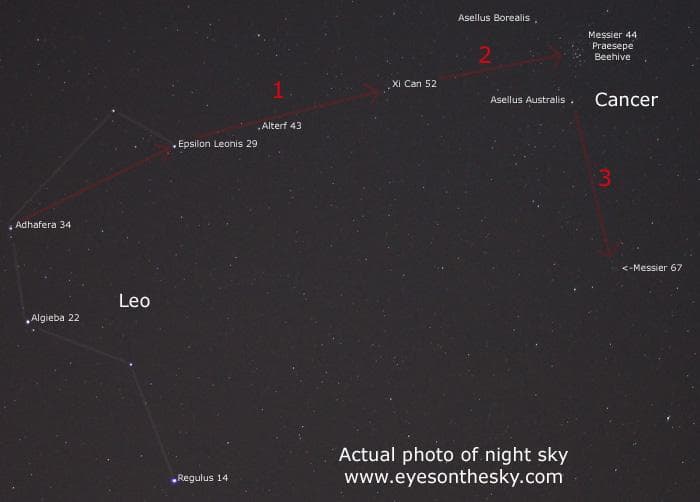
with David Fuller

Hop 1, 2, 3 for M67
Messier 67 gets no respect. It's the smaller open cluster in Cancer the Crab, always overshadowed by the more impressive Messier 44 (clearly, as Charles Messier himself even wrote down the Beehive as an "object" to round out his initial list before ever spotting M67). But that doesn't mean it's not worth viewing. See, it is one of the older - and closest/older - open cluster in the sky. NGC188 is perhaps slightly, but more likely significantly, older, and also somewhat close by to us
Unfortunately for us, it is stuck in this "empty" section of sky, also known as Cancer the Crab to us. With no star brighter than 4-th magnitude, it's almost like the Crab is laughing at us, saying, "HAHA! I've got some great objects here, but I'm NOT going to make it easy to find them!" Okay, fine! But that doesn't mean we can't find easy ways to get there, despite the crab being... well, crabby about the whole thing.
Start at Leo. Somewhat well up in the sky from 40N latitude (lower if you're at higher latitudes, and higher in the sky if you're at lower latitudes), its brightest star is Regulus, easily seen even from city locations. Leo has a distinctive "sickle" shape to the head section of the lion, forming the "mane" of the big cat. (See diagram below.)
Now, the key to making this hop successfully is knowing the right optics to use. A telescope, for the moment, has too narrow a field of view. Instead, use either a good sized finderscope - say, 8x40 or 9x50 - or binoculars. Smaller finders may work in areas of less light polluton. But here's the key: You want to have a finder with a field of view that is around 6 yo 8 degrees.
Why?
Most of the "hops" will be taking are about 7 degrees.
So from Regulus, locate Algieba. This is a 2.2 magnitude star, and from most locations is also visible naked eye. To the north from there - remember, "north" means drawing a line towards Polaris, not towards due north - is Adhafera. At 3.4 magnitude, this star will either require optical aid or be on the edge of naked eye visibility from moderate light pollution. At less than 4 degrees from Algieba, you can place both in the same finder field of view. And Adhafera is a neat sight - two 6th magnitude stars are on either side of it. Take a moment to savor that view.
(While you're in the area, look for double star 27 Hya near Alphard too.)
So far so good, right! Now it gets more challenging.
Turn to the west (right) about 120 degrees. and go a full field of view. This will take you to Epsilon Leonis. It is a half magnitude brighter than Adhafera, but don't confuse it with Rasalis, to it's north, which is dimmer than Adhafera. This line - Adhafera to Epsilon - is the general direction we want to go.
Now hop with me.
With Epsilon centered, move ever so slightly in that same direction. You're going to pick up a 4th magnitude star at the edge of your field - in fact, it may be there with Epsilon centered. That is 4.3 magnitude Alterf, more than a magnitude fainter than Epsilon, but easily visible in most binoculars. Okay, center it, and keep going. Before Alterf leaves the field, you'll see 5.2 magnitude Xi Cancri enter the field. It will be a magnitude fainter than Alterf. You'll see 6th magnitude 79 Cancri right next to it. Now keep going, the same direction.
Here is where it gets interesting.
You will see two 4th magnitude stars. The northern one, Asellis Borealis, is 4.7 magnitude and fainter. The southern one, Asellis Australis, is brighter, at magnitude 4.0, similar to what Alterf was. But what lies between them is what's magnificent.
You've just found where Messier 44 is!
I know, I know - I was just complaining about how M67 gets not respect due to M44, but this is a wonderful cluster to see. Even if you do go no further, you've really found a fantastic sight in the sky. And you're already using the right optics to see it - binoculars or a wide-field finderscope view are the best options for viewing it, because the cluster has such a large angular diameter from our perspective.
But we are not done! (scroll below graphic for more)

Above: Leo and Cancer are of the night sky, with a detailed stop hop to find the open cluser Messier 67 in Cancer. Star magnitudes do not include decimal points to avoid confusion (e.g. 4.3 star is listed as 43). Use 7x50 binoculars initially, then a telescope.
Use Asellis Borealis and Asellis Australis as your guide now. Make a line through them - so you're going to move south (down) now - and head that direction. Asellis Borealis will leave your field of view. As Asellis Australis gets to the edge, take a careful look at the field of view there on the opposite side. This is your target area. You should see four, 4th and th magnidue stars. The could almost be like a smiley shape (with no eyes), and the middle "tooth" missing. You can even see those stars in the photo above. They will take up about 1/2 to 2/3 of your entire field of view, as they are about 4 degrees across.
Now here's the important part: Where that "missing tooth" would be?
That is the location of Messier 67!
Yes, that's a LONG way to go just to find a star cluster, but not everyone knows how to star hop, and I wanted to go from the brightest object (Regulus) and see all the interesting things along the way, before getting to Messier 67. You MAY see a faint fuzz here with binoculars (darker skies will help!), but this cluster probably needs a telescope, and the larger the better, but a 114mm one will start to reveal it nicely. Use lower magnification, as the cluster is pretty decent sized. With several 9th and 10th magnitude stars, you'll be able to begin resolving detail in it with a 6" or larger scope. You'll want to look for this cluster when the sky darker, so shoot for a night when the Moon is not out - this week, try on the weekend during the evening, before the Moon rises.
